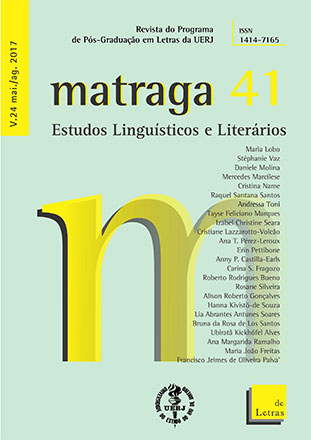Does the animacy of the antecedent play a role in the production of relative clauses?
DOI:
https://doi.org/10.12957/matraga.2017.28710Keywords:
language acquisition, relative clauses, animacyAbstract
In previous studies that included elicited production and comprehension tasks (Costa, Lobo and Silva 2011), it has been shown that there is a high discrepancy between the rates of production of subject relative clauses vs. object relative clauses both in children and adults, but the two groups differed qualitatively. In the comprehension task, adults performed very well, unlike children, who had trouble with object relative clauses. This points to a specific difficulty with structures that involve intervention (Friedmann, Belletti and Rizzi 2009). In the present study, we investigated the role of animacy features of the antecedent in the production of object relative clauses, and specifically whether the production of object relatives would be higher with inanimate antecedents. Previous studies have mentioned the animacy features of the arguments as relevant (Corrêa 1994; Goodluck 2005; Kidd et al. 2007; Durrleman, Bentea and Guasti 2016). We explore the relevance of the findings for the discussion on the nature of the asymmetry between subject and object relative clauses. We analyze data from a spontaneous production corpus of a young European Portuguese speaking child that confirm that object relatives often have inanimate antecedents. We also conducted an elicited production task, inspired on Novogrodsky and Friedmann 2006, which elicited relative clauses manipulating the animacy of the antecedent. 42 European Portuguese children aged 4 to 6 participated in this task, as well as a control group of 20 adults. Results from the elicited production task show a higher production of object relatives with inanimate antecedents in both groups, although the difference was only significant for the adults. We conclude that the animacy of the antecedent is a feature that may play a role in the production of relatives.
---
Original in English.
---
DOI: http://dx.doi.org/10.12957/matraga.2017.28710
Downloads
Downloads
Published
How to Cite
Issue
Section
License
Authorization
Matraga – Scientific Journal of the Post-graduate Program in Arts and Humanities of UERJ is authorized to publish the article submitted here, if it is accepted for online publication. It is attested that the contribution is original, that it is not being submitted to another publisher for publication, and that this statement is the expression of truth.
The works published in Matraga's virtual space – Scientific Journal of the Post-graduate Program in Arts and Humanities of UERJ will be automatically transferred, and your copyright is reserved to Matraga. Its reproduction, in whole or in part, is conditional on the citation of the authors and the data of the publication.

Matraga uses license Creative Commons - Attribution-Non-Commercial 4.0 International.





